
Special Article – Gait Rehabilitation
Phys Med Rehabil Int. 2015; 2(9): 1066.
Short-term Performance-based Error-augmentation versus Error-reduction Robotic Gait Training for Individuals with Chronic Stroke: A Pilot Study
Kao PC¹*, Srivastava S², Higginson JS³, Agrawal SK4 and Scholz JP5
¹Department of Physical Therapy, University of Massachusetts Lowell, USA
²Department of Health Sciences and Research, Medical University of South Carolina, USA
³Department of Mechanical Engineering, University of Delaware, USA
4Department of Mechanical Engineering, Columbia University, USA
5Biomechanics and Movement Science Program, University of Delaware, USA
*Corresponding author: Pei-Chun Kao, Department of Physical Therapy, University of Massachusetts Lowell, USA
Received: September 15, 2015; Accepted: November 09, 2015; Published: November 12, 2015
Abstract
The success of locomotion training with robotic exoskeletons requires identifying control algorithms that effectively retrain gait patterns in neurologically impaired individuals. Here we report how the two training paradigms, performancebased error-augmentation versus error-reduction, modified walking patterns in four chronic post-stroke individuals as a proof-of-concept for future locomotion training following stroke. Stroke subjects were instructed to match a prescribed walking pattern template derived from neurologically intact individuals. Target templates based on the spatial paths of lateral ankle malleolus positions during walking were created for each subject. Robotic forces were applied that either decreased (error-reduction) or increased (error-augmentation) the deviation between subjects’ instantaneous malleolus positions and their target template. Subjects’ performance was quantified by the amount of deviation between their actual and target malleolus paths. After the error-reduction training, S1 showed a malleolus path with reduced deviation from the target template by 16%. In contrast, S4 had a malleolus path further away from the template with increased deviation by 12%. After the error-augmentation training, S2 had a malleolus path greatly approximating the template with reduced deviation by 58% whereas S3 walked with higher steps than his baseline with increased deviation by 37%. These findings suggest that an error-reduction force field has minimal effects on modifying subject’s gait patterns whereas an error-augmentation force field may promote a malleolus path either approximating or exceeding the target walking template. Future investigation will need to evaluate the long-term training effects on over-ground walking and functional capacity.
Keywords: Force field; Gait rehabilitation; Rehabilitation robotics; Stroke; Walking
Introduction
Robotic leg exoskeletons have been developed to assist gait rehabilitation for individuals with neurological disorders [1]. Incorporating robotic devices into training can substantially reduce physical demands on therapists and provide more precise guidance than conventional therapist-assisted training [2]. However, recent large-scale randomized controlled trials demonstrated that robotassisted locomotion training was worse than or not superior to the conventional physical therapy or therapist-assisted treadmill training [3-6]. It is possible that the excessive guidance and stabilization provided by the robotic exoskeleton interferes with learning and reduces subjects’ effort [7].
One way to ensure the success of gait rehabilitation with robotic exoskeletons is to identify robotic control algorithms that facilitate motor learning in people with neurological disorders [8]. An assistas- needed paradigm, providing guidance only when needed, is employed in some current leg exoskeletons [9-12]. Generally, the assist-as-needed guidance reduces the deviation between subject’s movement pattern and a prescribed pattern. We refer to this paradigm as performance-based error-reduction. The nature of this paradigm would minimize subject’s performance errors [13] which are important for motor learning [14]. This is potentially problematic for chronic stroke survivors since they do not recognize errors in their performance and enhancing those errors may enhance motor learning [15].
A performance-based error-augmentation paradigm may have the potential to better engage subject’s in the training. Because the performance-based error-augmentation paradigm amplifies subjects’ movement errors, this type of protocol would favour motor learning principles such as encouraging active participation [16] and physical effort [17], preserving movement variability [18, 19] and allowing subjects to discover normal movement patterns. Here we report how four chronic post-stroke individuals responded to the performancebased error-augmentation versus error-reduction training as a proofof- concept for future locomotion training following stroke.
Device Description
Training was performed using a unilateral robotic leg exoskeleton (Figure 1). Details of the exoskeleton’s design and algorithms of force field are documented elsewhere [11, 20, 21]. Briefly, when the force field is active, motors mounted at the hip and knee joints of the exoskeleton provide a pattern of torques with a resulting force applied to the ankle. Target walking templates based on the spatial paths of neurologically intact volunteers’ lateral malleolus positions (i.e., malleolus path) during walking were created for each subject (Figure 2). The performance-based force field was programmed as a non-linear virtual spring [11, 20, 22-24], applying a normal force towards (error-reduction) or away from (error-augmentation) the prescribed template (Figure 2). The amount and direction of the normal force varied depending on the deviation between subjects’ instantaneous malleolus position and their prescribed template.
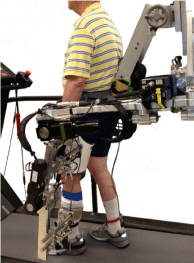
Figure 1: ALEX II (Second version of the Active Leg EXoskeleton).
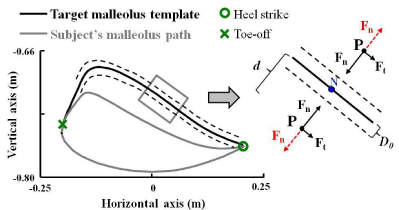
Figure 2: Malleolus path template and the performance-based force fields.
d is the distance between the subject’s current lateral malleolus position (P)
and the nearest point on the target template (N). D0 is defined as the width of
the virtual wall. The normal forces (Fn) were produced only when the distance
between P and N exceeded D0. The tangential forces (Ft) were minimal,
designed to ensure that the subjects’ leg produced continuous movement
along the malleolus path. When the deviation of the subject’s instantaneous
malleolus position (P) from the target template exceeds D0, the performancebased
error-augmentation algorithm would take the subject’s leg further away
from the target (N) (see Fn in red dashed line) whereas the performancebased
error-reduction algorithm would bring the subject’s leg towards the
target (N) (see Fn in solid black line).
Training
Stroke subjects received training on four consecutive days and one bout of training two days later (Figure 3). The training speed was determined as 125% of their preferred speed (Table 1). Each regular session consisted of six 5-minute training bouts (T1-T6) and a 2-minute evaluation bout before the training (Baseline), and after T6 (Post-Test). Day Five included a training bout and evaluation bouts before and after the training. Subjects were provided with a visual display of their instantaneous malleolus position and target template for a total of five training bouts (Figure 3). Subjects were instructed to walk in such a way that would minimize robotic forces and match the target template when the visual display was present.
S1
S2
S3
S4
Paradigm
error-
reduction
error-
augmentation
error-
augmentation
error-
reduction
Self-selected speed (mph)
1.3
0.9
1.2
1.1
Training speed (mph)
1.7
1.1
1.5
1.4
Age (years)
65
57
51
50
Gender (M/F)
M
F
M
M
Height (m)
1.75
1.50
1.73
1.79
Weight (kg)
70
67.3
68.1
72.5
Time since stroke (years)
8.5
4.4
4.2
3.7
Type of stroke
Ischemic
Ischemic
Ischemic
Ischemic
Device used during daily walking
none
none
AFO, single-point cane
Single-point cane
Lower-limb Fugl-Meyer(max = 34)
25
28
20
23
Berg balance scale (max = 56)
53
54
54
53
Functional gait assessment(max = 30)
16
15
14
13
Table 1: Participant characteristics.

Figure 3: The training protocol included four 6-bout training sessions on four
consecutive days (Days 1-4) and a 1-bout training session two days later
(Day 5). Real-time visual display of the subject’s instantaneous malleolus
positions and target malleolus path was provided for a total of five bouts.
For all evaluation trials (not shown here), no force field or visual display
of malleolus paths was provided to the subjects. Subjects walked with the
exoskeleton in zero-torque mode for the evaluation bouts but walked with a
performance-based force field for the training bouts.
Case Presentation
Four stroke survivors gave written informed consent and participated in this short-term robotic gait training study, approved by the University’s Institutional Review Board. S1 and S4 received performance-based error-reduction training whereas S2 and S3 received performance-based error-augmentation training. Subjects’ specific characteristics are listed in Table 1. Subjects were included if they had chronic stroke involving cerebral cortical regions, single lesion, noticeable gait deviation, ability to walk without an orthoses, normal or corrected normal vision, and ability to follow instructions. The exclusion criteria were uncontrolled hypertension (>190/110 mmHg), evidence of chronic white matter disease or cerebellar stroke on MRI, or any medical condition, other than stroke, that affects walking ability.
Subjects’ performance during the training was quantified by the amount of deviation between their actual and target malleolus paths estimated by the area enclosed between the two paths during the swing phase (Total Area). We also identified and summed regions where subject’s malleolus paths were above (Area Above) or below (Area Below) their target template.
Performance-based error-reduction training results
Subject 1: S1 walked with shallower malleolus paths than the target template before the training, evidenced by the large area below the template (Baseline on Day1, Total Area: 123.8±13.0 cm2, Area Above: 9.4±5.5 cm2, Area Below: 114.4±11.1 cm2) (Figure 4). After the training, S1 still walked with lower average step heights than the target template although his malleolus paths were closer to the target template. S1 reduced Total Area by ~16% with a decrease of ~47% in Area Below and an increase of ~31% in Area Above on Day Five, indicating a greater step height compared to Day One. Correspondingly, S1 increased the swing-phase peak hip and knee flexion by ~1 and ~8 degrees, respectively, on Day Five (Table 2). Ankle motion was not directly targeted during the training. However, S1 had a decrease of ~3 degrees in the swing-phase peak ankle dorsiflexion on Day Five.
Baseline
peak hip flexion
peak knee flexion
peak dorsiflexion
S1
Day1
38.9° ± 1.3°
31.0° ± 1.6°
-11.1° ± 4.2°
Day5
39.8° ± 1.4°
39.4° ± 1.8°
-13.8° ± 2.7°
S2
Day1
38.7° ± 1.9°
45.2° ± 2.7°
-13.5° ± 2.2°
Day5
29.2° ± 3.9°
34.1° ± 4.7°
-3.3° ± 4.7°
S3
Day1
30.2° ± 1.4°
34.4° ± 2.5°
-16.1° ± 3.3°
Day5
39.6° ± 0.8°
40.9° ± 2.6°
-9.7° ± 2.6°
S4
Day1
22.8° ± 2.5°
19.3° ± 6.2°
-1.3° ± 3.4°
Day5
17.5° ± 1.4°
15.9° ± 3.9°
-3.9° ± 2.8°
Table 2: Peak joint flexion angle during swing.
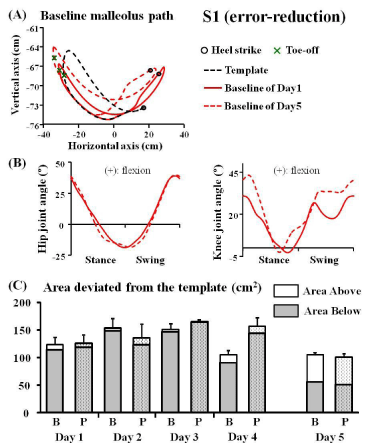
Figure 4: (A) S1’s baseline malleolus paths and prescribed target template,
(B) hip and knee joint kinematics, and (C) area between actual and prescribed
malleolus paths. (A) S1’s baseline malleolus paths are shown for Day One
(red solid line) and Day Five (red dashed line). The black dashed line
represents the prescribed target template of S1. (B) S1’s hip and knee joint
kinematics over the gait cycle are shown for Day One (red solid line) and Day
Five (red dashed line). (C) Mean data ± 1 standard deviation across strides
are shown for the evaluation bout before (Baseline, B) and after the training
(Post-test, P) on each day. The white region represents Area Above whereas
the grey region represents Area Below. A smaller Total Area indicates less
deviation from the target template, and vice versa.
Subject 4: S4 walked with shallower malleolus paths compared to the target template before the training (Baseline on Day1, Total Area: 120.0±18.2 cm2, Area Above: 2.6±0.0 cm2, Area Below: 117.4±1.0 cm2) (Figure 5). After the training, S4 showed a trend to walk with even lower average step heights and had malleolus paths further away from the target template. On Day Five, S4 increased Total Area by ~12% with an increase of 14% in Area Below and a decrease of 2% in Area Above. Correspondingly, S4 reduced the swing-phase peak hip flexion, peak knee flexion and peak ankle dorsiflexion by ~5, ~3 and ~3 degrees, respectively, on Day Five compared to Day One (Table 2).
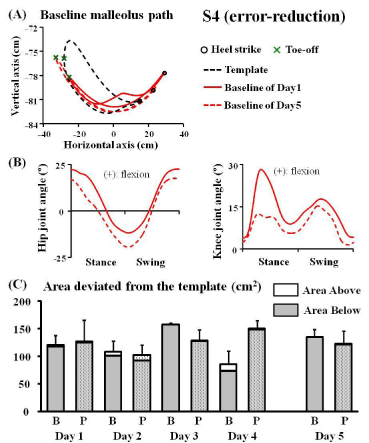
Figure 5: (A) S4’s baseline malleolus paths and prescribed target template,
(B) hip and knee joint kinematics, and (C) area between actual and prescribed
malleolus paths.
Performance-based error-augmentation training results
Subject 2: S2 walked with exaggerated average step heights before the training (Baseline on Day1, Total Area: 125.2±18.2 cm2, Area Above: 125.0±18.6 cm2, Area Below: 0.2±0.9 cm2) (Figure 6). After the training, S2 was able to lower the stepping height and walked with malleolus paths closer to the target template. On Day Five, S2 had a reduction of ~58% in Total Area by having a decrease of ~73% in Area Above and an increase of ~14% in Area Below compared to Day One. Correspondingly, S2 reduced the swing-phase peak hip and knee flexion by ~9 and ~11 degrees, respectively, on Day Five compared to Day One (Table 2). Contrary to the changes in hip and knee kinematics, S2 had an increase of ~10 degrees in the peak swing-phase ankle dorsiflexion, indicating that more control in the ankle motion may have been incorporated to ensure sufficient foot clearance.
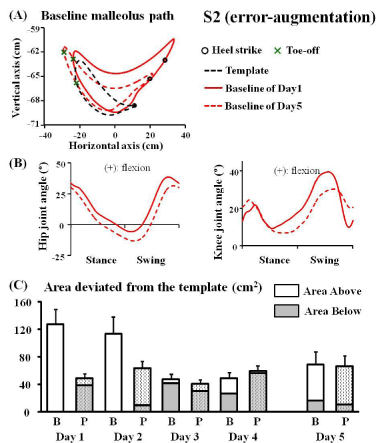
Figure 6: (A) S2’s baseline malleolus paths and prescribed target template,
(B) hip and knee joint kinematics, and (C) area between actual and prescribed
malleolus paths.
Subject 3: S3 walked with average malleolus paths lower than the target template during initial-to-mid swing but higher than the template during mid-to-late swing before the training (Baseline on Day1, Total Area: 110.0±10.1 cm2, Area Above: 57.7±15.1 cm2, Area Below: 53.2±15.7 cm2) (Figure 7). After the training, S3 walked with even higher steps than his Day One baseline. On Day Five, S3 had greater Total Area by 37% with an increase of 63% in Area Above and a decrease of 26% in Area Below compared to Day One. Correspondingly, the peak hip and knee flexion angles were increased by ~9 and ~6 degrees, respectively, on Day Five compared to Day One (Table 2). In addition, the swing-phase peak ankle dorsiflexion was increased by ~6 degrees, indicating a less plantar flexed ankle position during swing.
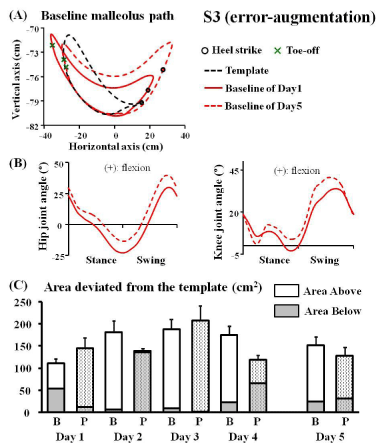
Figure 7: (A) S3’s baseline malleolus paths and prescribed target template,
(B) hip and knee joint kinematics, and (C) area between actual and prescribed
malleolus paths.
Discussion
This case report provided a preliminary comparison of short- term gait changes due to a performance-based error-augmentation versus error-reduction gait retraining paradigm for individuals post-stroke. The performance-based error-augmentation force field was well tolerated by the post-stroke subjects, evidenced by their ability to complete six bouts of training without reporting fatigue or discomfort. Results of this study were mixed but tended to support some predictions that a performance-based error-augmentation force field would have more effects on modifying participants’ gait patterns compared to the error-reduction force field after four days of training. However, as evidenced by the results, an error-augmentation force field would promote a malleolus path that either approximates or exceeds the target template. Thus, whether performance-based erroraugmentation training provides an advantage over error-reduction training certainly requires further investigation.
This investigation has some limitations. The four subjects were all independent community ambulators [25]. The nature of responses to the training paradigm may depend on the severity of subject’s motor impairments [26] or their pre-training gait patterns. In addition, we could not exclude some of the learning effect from simply tracking the target template via the visual feedback. Krishnan et al (2012, 2013) [27, 28] demonstrated that moderately impaired stroke survivors increased active participation and improved their motor function by repeatedly practicing a target-tracking task in a robotic leg exoskeleton that did not apply robotic forces to augment or reduce subject’s performance errors.
Conclusion
This case report serves as an initial evaluation of the effectiveness of robotic performance-based error-augmentation versus errorreduction gait training paradigms in people post-stroke. Robotic performance-based training protocols were well tolerated by the poststroke subjects. The current results suggest that an error-augmentation force field may be more effective than an error-reduction force field in modifying subject’s overall gait patterns. Future work will evaluate the long-term therapeutic efficacy of performance-based erroraugmentation training on community-based walking and functional capacity.
Acknowledgements
The authors thank Damiano Zanotto and Paul Stegall for assistance with technical issues related to the computer program and hardware of the leg exoskeleton. This work was supported by NIH grant R01HD038582.
References
- Bogey R, Hornby GT. Gait training strategies utilized in poststroke rehabilitation: are we really making a difference? Top Stroke Rehabil. 2007; 14: 1-8.
- Backus D, Winchester P, Tefertiller C. Translating research into clinical practice: integrating robotics into neurorehabilitation for stroke survivors. Top Stroke Rehabil. 2010; 17: 362-370.
- Vaney C, Gattlen B, Lugon-Moulin V, Meichtry A, Hausammann R, Foinant D, et al. Robotic-assisted step training (lokomat) not superior to equal intensity of over-ground rehabilitation in patients with multiple sclerosis. Neurorehabil Neural Repair. 2012; 26: 212-221.
- Schwartz I, Sajin A, Moreh E, Fisher I, Neeb M, Forest A, et al. Robot-assisted gait training in multiple sclerosis patients: a randomized trial. Mult Scler. 2012; 18: 881-890.
- Hornby TG, Campbell DD, Kahn JH, Demott T, Moore JL, Roth HR. Enhanced gait-related improvements after therapist- versus robotic-assisted locomotor training in subjects with chronic stroke: a randomized controlled study. Stroke. 2008; 39: 1786-1792.
- Hidler J, Nichols D, Pelliccio M, Brady K, Campbell DD, Kahn JH, et al. Multicenter randomized clinical trial evaluating the effectiveness of the Lokomat in subacute stroke. Neurorehabil Neural Repair. 2009; 23: 5-13.
- Israel JF, Campbell DD, Kahn JH, Hornby TG. Metabolic costs and muscle activity patterns during robotic- and therapist-assisted treadmill walking in individuals with incomplete spinal cord injury. Phys Ther. 2006; 86: 1466-1478.
- Marchal-Crespo L, Reinkensmeyer DJ. Review of control strategies for robotic movement training after neurologic injury. J Neuroeng Rehabil. 2009; 6: 20.
- Duschau-Wicke A, Caprez A, Riener R. Patient-cooperative control increases active participation of individuals with SCI during robot-aided gait training. J Neuroeng Rehabil. 2010; 7: 43.
- Emken JL, Harkema SJ, Beres-Jones JA, Ferreira CK, Reinkensmeyer DJ. Feasibility of manual teach-and-replay and continuous impedance shaping for robotic locomotor training following spinal cord injury. IEEE transactions on bio-medical engineering. 2008; 55: 322-334.
- Banala SK, Kim SH, Agrawal SK, Scholz JP. Robot assisted gait training with active leg exoskeleton (ALEX). IEEE Trans Neural Syst Rehabil Eng. 2009; 17: 2-8.
- Srivastava S, Kao PC, Kim SH, Stegall P, Zanotto D, Higginson J, et al. Assist-as-Needed Robot-Aided Gait Training Improves Walking Function in Individuals Following Stroke. IEEE transactions on neural systems and rehabilitation engineering: a publication of the IEEE Engineering in Medicine and Biology Society. 2014.
- Emken JL, Benitez R, Reinkensmeyer DJ. Human-robot cooperative movement training: learning a novel sensory motor transformation during walking with robotic assistance-as-needed. J Neuroeng Rehabil. 2007; 4: 8.
- Shadmehr R, Smith MA, Krakauer JW. Error correction, sensory prediction, and adaptation in motor control. Annu Rev Neurosci. 2010; 33: 89-108.
- Reisman DS, McLean H, Keller J, Danks KA, Bastian AJ. Repeated split-belt treadmill training improves poststroke step length asymmetry. Neurorehabil Neural Repair. 2013; 27: 460-468.
- Lotze M, Braun C, Birbaumer N, Anders S, Cohen LG. Motor learning elicited by voluntary drive. Brain. 2003; 126: 866-872.
- Koenig A, Omlin X, Bergmann J, Zimmerli L, Bolliger M, Müller F, et al. Controlling patient participation during robot-assisted gait training. J Neuroeng Rehabil. 2011; 8: 14.
- Cai LL, Fong AJ, Otoshi CK, Liang Y, Burdick JW, Roy RR, et al. Implications of assist-as-needed robotic step training after a complete spinal cord injury on intrinsic strategies of motor learning. J Neurosci. 2006; 26: 10564-10568.
- Lewek MD, Cruz TH, Moore JL, Roth HR, Dhaher YY, Hornby TG. Allowing intralimb kinematic variability during locomotor training poststroke improves kinematic consistency: a subgroup analysis from a randomized clinical trial. Phys Ther. 2009; 89: 829-839.
- Zanotto D, Rosati G, Spagnol S, Stegall P, Agrawal S. Effects of Complementary Auditory Feedback in Robot-Assisted Lower Extremity Motor Adaptation. IEEE transactions on neural systems and rehabilitation engineering: a publication of the IEEE Engineering in Medicine and Biology Society. 2013.
- Winfree KN, Stegall P, Agrawal SK. Design of a minimally constraining, passively supported gait training exoskeleton: ALEX II. IEEE Int Conf Rehabil Robot. 2011; 2011: 5975499.
- Kao PC, Srivastava S, Agrawal SK, Scholz JP. Effect of robotic performance-based error-augmentation versus error-reduction training on the gait of healthy individuals. Gait Posture. 2013; 37: 113-120.
- Stegall P, Winfree K, Zanotto D, Agrawal SK. Rehabilitation Exoskeleton Design: Exploring the Effect of the Anterior Lunge Degree of Freedom. Ieee T Robot. 2013; 29: 838-846.
- Banala SK, Kulpe A, Agrawal SK. A powered leg orthosis for gait rehabilitation of motor-impaired patients. IEEE International Conference on Robotics and Automation, Roma, Italy, 2007: 4140-4145.
- Perry J, Garrett M, Gronley JK, Mulroy SJ. Classification of walking handicap in the stroke population. Stroke. 1995; 26: 982-989.
- Wu M, Landry JM, Schmit BD, Hornby TG, Yen SC. Robotic resistance treadmill training improves locomotor function in human spinal cord injury: a pilot study. Arch Phys Med Rehabil. 2012; 93: 782-789.
- Krishnan C, Ranganathan R, Dhaher YY, Rymer WZ. A pilot study on the feasibility of robot-aided leg motor training to facilitate active participation. PLoS One. 2013; 8: e77370.
- Krishnan C, Ranganathan R, Kantak SS, Dhaher YY, Rymer WZ. Active robotic training improves locomotor function in a stroke survivor. J Neuroeng Rehabil. 2012; 9: 57.